Sat Mag
Givantha Arthasad animates life

By Uditha Devapriya
On the way to Moratuwa from Piliyandala you cross the Bolgoda Bridge, where the path bifurcates between the road to Katubedda on your right and the road to Rawathawatta on your left. The road to Rawathawatta is smaller, and yet more crowded: you pass countless furniture shops, fruit and vegetable stalls, fishmongers, and grocery stores, as well as a church and a temple. After driving on for two kilometres, you wind into a suburb called Shramadhana Road, which forks into several small lanes.
This is where Givantha Arthasad lives.
I initially found it difficult to locate him, because of the maze-like lanes that lead to his house. Once I found it, however, all those other houses seemed to vanish before me; this one looked like it stood a world or two apart from them.
A series of steps lead to a lower elevation, with copious shrubs and bushes flanking either side. The veranda, where I sat down to meet the man I had come to talk to, was adorned with so much craftwork and so many designs, including paintings and clay figures, that I could only be awed. I felt like I had walked into a lair.
Givantha Arthasad likes to call himself an artist. What kind of artist? Diplomatically, he refrains from answering. For someone who led so many lives – graphic designing, painting, photography, drama, cinema, television, broadcasting, and journalism – calling him an artist hardly captures his versatility, since his contributions surpass anything a crass generalisation of that sort can lead us to assume. This is his story.
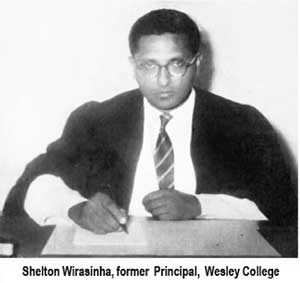 He was born Baminihennedige Givantha Arthasad Peiris in Katunayake to a religiously devout father and mother, both of whom were involved in education: his father, George A. Peiris, was the Scout Commissioner of Sri Lanka, while his mother, Dulcie Peiris, worked as a teacher. “I initially attended Methodist College in my hometown, where my father served as principal, before being sent to Wesley College Colombo from Grade Two.”
He was born Baminihennedige Givantha Arthasad Peiris in Katunayake to a religiously devout father and mother, both of whom were involved in education: his father, George A. Peiris, was the Scout Commissioner of Sri Lanka, while his mother, Dulcie Peiris, worked as a teacher. “I initially attended Methodist College in my hometown, where my father served as principal, before being sent to Wesley College Colombo from Grade Two.”
Givantha inherited his artistic touch from his parents. “My mother used to bring children in our neighbourhood to our home, where she taught them to make toys, sculpt, and paint for free. Naturally, she taught me too.” His father, on the other hand, taught him “to read newspapers upside down, and to read aloud, paying close attention to the dramatic nuances of a passage.”
With these early encounters, he moved on to Wesley. His first class teacher there had seen him paint, and, since he painted well for his age, had even once remarked, “You shouldn’t have been born in a country like this.” That classteacher was Cyril Wickramage.
He hadn’t been the only staff member who’d encouraged his talent. “My Grade Three class teacher, Mrs Ivy Marasinghe, used to conduct art classes after school which we helped her with. During weekends she took us to watch cartoons. That’s where I encountered the world of animation, from Mickey Mouse to Donald Duck.”
 Surprisingly for someone who loved to draw, young Givantha opted for science at Wesley. This became a problem when his studies clashed with his desire to paint and to submit what he painted to various art competitions. The principal of Wesley back then, the renowned educationalist Shelton Wirasinha, had to sign his work before it could be despatched, “and almost every time I went to his office, he’d say something to the tune of ‘Putha, we can’t do this every day, it would be better if you chose art.’”
Surprisingly for someone who loved to draw, young Givantha opted for science at Wesley. This became a problem when his studies clashed with his desire to paint and to submit what he painted to various art competitions. The principal of Wesley back then, the renowned educationalist Shelton Wirasinha, had to sign his work before it could be despatched, “and almost every time I went to his office, he’d say something to the tune of ‘Putha, we can’t do this every day, it would be better if you chose art.’”
Not that he cut himself from science. In fact, physics had been one of his favourite subjects. “As I moved up, I graduated from geometry to mechanical drawing. I can’t say these didn’t influence my career. For instance, when we draw, the foundation for our work is the line and the circle. No matter what those who try to divide art and science try to say, there will always be a scientific aspect to drawing. I realised this very early on.”
Still, as he confesses, “Mr Wirasinha’s prodding caused me to wonder whether I ought to be studying science.” Fortunately for him, through the intervention of Wirasinha and Jayantha Premachandra, the head of the Arts Section, he shifted from the science stream to Arts. As for his elders, “my father had wanted me to become a parson due to a promise they’d made to God after the death of my elder brother.” But they gave into his wishes. “After my O Levels, they allowed me to do what I pleased.”
The problem for Givantha was that no institution taught the field he had chosen. “The only place I could go to was Heywood. But Heywood taught music. I realised soon that it wasn’t my cup of tea, so I decided to teach myself.” He reckoned that “an opportunity would come my way.”
The opportunity did come, much sooner than he’d reckoned.
 Linus Dissanayake, a doctor turned film producer, had started a small but prominent studio called Dissanayake Studios. It had bankrolled Professor Siri Gunasinghe’s groundbreaking film Sath Samudura in 1967, which featured a breakthrough performance by Givantha’s first class teacher at Wesley, Cyril Wickramage. Three years later the studio financed another landmark production, Vasantha Obeyesekere’s Wes Gaththo, also starring Cyril.
Linus Dissanayake, a doctor turned film producer, had started a small but prominent studio called Dissanayake Studios. It had bankrolled Professor Siri Gunasinghe’s groundbreaking film Sath Samudura in 1967, which featured a breakthrough performance by Givantha’s first class teacher at Wesley, Cyril Wickramage. Three years later the studio financed another landmark production, Vasantha Obeyesekere’s Wes Gaththo, also starring Cyril.
By the time of Wes Gaththo’s release, Givantha had come into contact with Dissanayake, “from whom I borrowed a camera and went on to make a short animated sketch on Andare. The Film Critics’ and Journalists’ Association nominated it for their annual Short Film Festival in 1971, where I competed with Sunil Ariyaratne and Dharmasena Pathiraja.”
Givantha’s next destination was Ceylon Theatres, where, thanks to his friendship with the comedian and singer Freddie Silva, he made contact with “a man called Derrick Fernando, who worked as an official there,” and Titus Thotawatte, “who taught me filmmaking and introduced me to Andrew Jayamanne, who taught me cinematography.”
By now he had made another animated short film, Muhuda Yatin Ira Payayi, which won for him a Jury Prize from the Film Critics’ and Journalists’ Association in 1972. His third attempt, seven years later, would leave behind a much larger imprint on cinema.
That third film, Dutugemunu, was not well received by officials at the time of its release in October 1979, though the few ordinary people who saw it had been thrilled by it. Based on an important episode from Sri Lankan history, its charm lay mainly in the dazzlingly novel way it presented an otherwise serious subject.
“I didn’t follow a conventional narrative,” Givantha tells me. “Instead of relating the story of the hero, I started with an unlikely beginning: a cat visiting the Ruwanwelisaya Dagaba with its kittens, which ask about the story behind its construction. From there the film relates the Mahavamsa version of events. The cat figures in those events because in one of its previous births, it had served as Dutugemunu’s purohita or chaplain.”
Boasting a prominent cast, including influential figures from Givantha’s own childhood (Cyril Wickramage voiced the eponymous hero, while Felix Premawardhana the thespian, who’d taught literature at Wesley, voiced his main soldier, Nandimitra), Dutugemunu concentrated on the hero’s search for the giants in his battle against Elara. With Henry Jayasena voicing Kavantissa and Givantha voicing various other characters, it was tipped to be a watershed. As things turned out though, “audiences barely noticed it.”
The issue hadn’t been with the audiences. It had instead been with political authorities. In 1977 the United National Party had come to power promising, on the one hand, a dharmista samajayak or a ‘righteous society’, and on the other, ethnic coexistence.
According to Givantha, “certain educationists thought the story of Dutugemunu was not amenable to coexistence, given the racialist overtones of his triumph over Elara. They made a complaint to the Education Ministry, which excised the story from textbooks and imposed a ban on any form of propagating it. That is why I was forced to take out my film right after I’d released it.” An avoidable tragedy, because the movie didn’t carry a racist message – “It was entertainment for kids based on Westerns like The Magnificent Seven!” as Givantha puts it – and also because the director had toiled hard to make its characters – including the sunglass-wearing cat that takes us through history – come alive onscreen.
How hard had he toiled, really? Consider that this was a time when digital cinema remained, even in the West, a distant dream. “I had to insert India ink on every frame. In each of my first two films I used more than a thousand such frames. Dutugemunu used more than that. You can imagine the concentration I had to put into these efforts.”
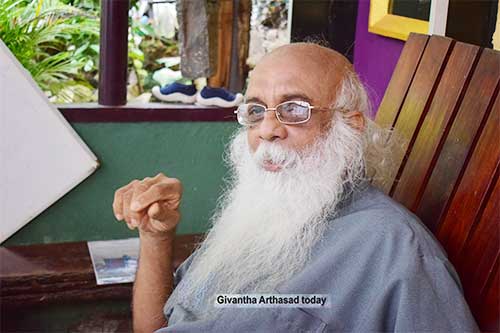 Mercifully, he didn’t have to suffer a loss due to the ban. Far from it, in fact: he tells me that “I bought this house with the compensation I got, for costs incurred on the production, from the authorities after they ordered theatres to stop screening my film.”
Mercifully, he didn’t have to suffer a loss due to the ban. Far from it, in fact: he tells me that “I bought this house with the compensation I got, for costs incurred on the production, from the authorities after they ordered theatres to stop screening my film.”
The controversy over Dutugemunu notwithstanding, Givantha proceeded to the next phase of his career. Six months before Dutugemunu’s release, television had made its entry to the country. The following year Givantha was sent to study television in Berlin. Upon his return he was posted to the Animation Division of the Sri Lanka Rupavahini Corporation. Later, through a request by the then State Minister Anandatissa de Alwis and then Secretary at the Ministry Sarath Amunugama, he got to work in various other Divisions as well.
In 1987 he tendered his resignation from Rupavahini, two years after he had discovered his eyesight was failing. “Dr Upali Mendis, the head of the Eye Hospital, told me my retina had got damaged, and I’d lose my sight in a few years. He said I would have to live with God. Well, God has been merciful to me. I can see clearly even now,” he tells me.
He also discovered a new career: stamp designing. On the walls of his veranda is a huge poster displaying his most prominent designs, including the 150th anniversary stamp of Royal College and a stamp issued to celebrate the opening of the Victoria Dam. Once again, in a pre-digital era, “drawing these wasn’t the easiest thing to do, even for an artist like me.” For the Victoria Dam stamp, for instance, Givantha had to personally visit and survey the site, “just to come up with a miniature graphical representation.”
In 2001, 22 years after Dutugemunu, Givantha made Sri Lanka’s first digitally animated film: Mahadana Muththayi Golayo Roththayi. Due to the then ongoing war, however, it too passed by unnoticed, though on those who saw it (including an eight year old me), it made a favourable impression. It certainly made an impression on the OCIC. At the 28th OCIC and UNDA Awards Ceremony the following year, it won a Special Jury Prize.
Last year he screened his third feature film – after Dutugemunu and Mahadana Muththayi Golayo Roththayi – called Eureka, for dignitaries and journalists. Unfortunately, it still hasn’t been released. There’s little doubt it’ll pass by noticed this time; in fact there’s reason to believe Givantha will get his long sought after place in the sun that his first two films barely garnered, and his third feature length masterpiece did not, with this newest venture.
The writer Thilakarathna Kuruwita Bandara describes Eureka as an experimental work that may well become “a turning point in the cinema for young directors.” Only time will tell if the film, as a whole, stands up to such an estimation. Until then, we can only wait.
The writer can be reached at udakdev1@gmail.com
Sat Mag
October 13 at the Women’s T20 World Cup: Injury concerns for Australia ahead of blockbuster game vs India
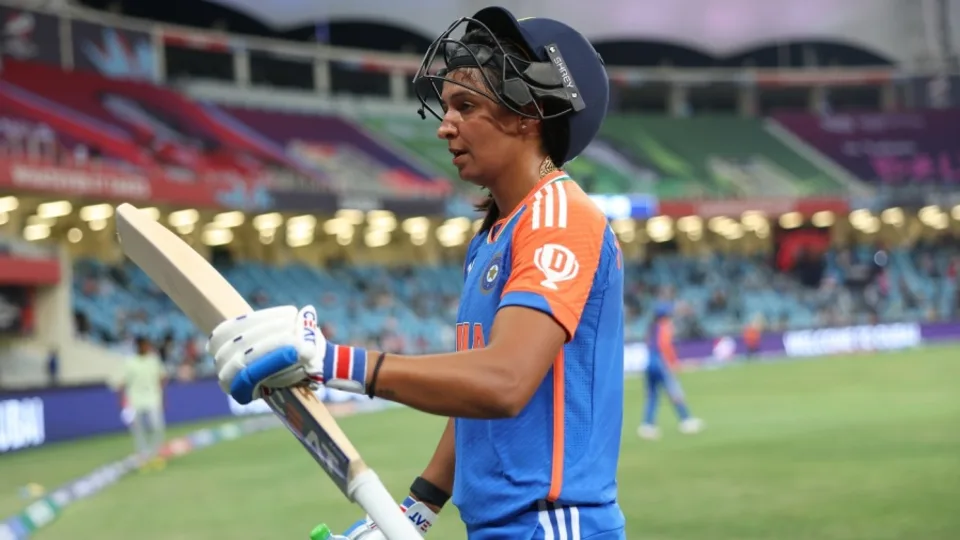
Australia vs India
Sharjah, 6pm local time
Australia have major injury concerns heading into the crucial clash. Just four balls into the match against Pakistan, Tayla Vlaeminck was out with a right shoulder dislocation. To make things worse, captain Alyssa Healy suffered an acute right foot injury while batting on 37 as she hobbled off the field with Australia needing 14 runs to win. Both players went for scans on Saturday.
India captain Harmanpreet Kaur who had hurt her neck in the match against Pakistan, turned up with a pain-relief patch on the right side of her neck during the Sri Lanka match. She also didn’t take the field during the chase. Fast bowler Pooja Vastrakar bowled full-tilt before the Sri Lanka game but didn’t play.
India will want a big win against Australia. If they win by more than 61 runs, they will move ahead of Australia, thereby automatically qualifying for the semi-final. In a case where India win by fewer than 60 runs, they will hope New Zealand win by a very small margin against Pakistan on Monday. For instance, if India make 150 against Australia and win by exactly 10 runs, New Zealand need to beat Pakistan by 28 runs defending 150 to go ahead of India’s NRR. If India lose to Australia by more than 17 runs while chasing a target of 151, then New Zealand’s NRR will be ahead of India, even if Pakistan beat New Zealand by just 1 run while defending 150.
Overall, India have won just eight out of 34 T20Is they’ve played against Australia. Two of those wins came in the group-stage games of previous T20 World Cups, in 2018 and 2020.
Australia squad:
Alyssa Healy (capt & wk), Darcie Brown, Ashleigh Gardner, Kim Garth, Grace Harris, Alana King, Phoebe Litchfield, Tahlia McGrath, Sophie Molineux, Beth Mooney, Ellyse Perry, Megan Schutt, Annabel Sutherland, Tayla Vlaeminck, Georgia Wareham
India squad:
Harmanpreet Kaur (capt), Smriti Mandhana (vice-capt), Yastika Bhatia (wk), Shafali Verma, Deepti Sharma, Jemimah Rodrigues, Richa Ghosh (wk), Pooja Vastrakar, Arundhati Reddy, Renuka Singh, D Hemalatha, Asha Sobhana, Radha Yadav, Shreyanka Patil, S Sajana
Tournament form guide:
Australia have three wins in three matches and are coming into this contest having comprehensively beaten Pakistan. With that win, they also all but sealed a semi-final spot thanks to their net run rate of 2.786. India have two wins in three games. In their previous match, they posted the highest total of the tournament so far – 172 for 3 and in return bundled Sri Lanka out for 90 to post their biggest win by runs at the T20 World Cup.
Players to watch:
Two of their best batters finding their form bodes well for India heading into the big game. Harmanpreet and Mandhana’s collaborative effort against Pakistan boosted India’s NRR with the semi-final race heating up. Mandhana, after a cautious start to her innings, changed gears and took on Sri Lanka’s spinners to make 50 off 38 balls. Harmanpreet, continuing from where she’d left against Pakistan, played a classic, hitting eight fours and a six on her way to a 27-ball 52. It was just what India needed to reinvigorate their T20 World Cup campaign.
[Cricinfo]
Sat Mag
Living building challenge

By Eng. Thushara Dissanayake
The primitive man lived in caves to get shelter from the weather. With the progression of human civilization, people wanted more sophisticated buildings to fulfill many other needs and were able to accomplish them with the help of advanced technologies. Security, privacy, storage, and living with comfort are the common requirements people expect today from residential buildings. In addition, different types of buildings are designed and constructed as public, commercial, industrial, and even cultural or religious with many advanced features and facilities to suit different requirements.
We are facing many environmental challenges today. The most severe of those is global warming which results in many negative impacts, like floods, droughts, strong winds, heatwaves, and sea level rise due to the melting of glaciers. We are experiencing many of those in addition to some local issues like environmental pollution. According to estimates buildings account for nearly 40% of all greenhouse gas emissions. In light of these issues, we have two options; we change or wait till the change comes to us. Waiting till the change come to us means that we do not care about our environment and as a result we would have to face disastrous consequences. Then how can we change in terms of building construction?
Before the green concept and green building practices come into play majority of buildings in Sri Lanka were designed and constructed just focusing on their intended functional requirements. Hence, it was much likely that the whole process of design, construction, and operation could have gone against nature unless done following specific regulations that would minimize negative environmental effects.
We can no longer proceed with the way we design our buildings which consumes a huge amount of material and non-renewable energy. We are very concerned about the food we eat and the things we consume. But we are not worrying about what is a building made of. If buildings are to become a part of our environment we have to design, build and operate them based on the same principles that govern the natural world. Eventually, it is not about the existence of the buildings, it is about us. In other words, our buildings should be a part of our natural environment.
The living building challenge is a remarkable design philosophy developed by American architect Jason F. McLennan the founder of the International Living Future Institute (ILFI). The International Living Future Institute is an environmental NGO committed to catalyzing the transformation toward communities that are socially just, culturally rich, and ecologically restorative. Accordingly, a living building must meet seven strict requirements, rather certifications, which are called the seven “petals” of the living building. They are Place, Water, Energy, Equity, Materials, Beauty, and Health & Happiness. Presently there are about 390 projects around the world that are being implemented according to Living Building certification guidelines. Let us see what these seven petals are.
Place
This is mainly about using the location wisely. Ample space is allocated to grow food. The location is easily accessible for pedestrians and those who use bicycles. The building maintains a healthy relationship with nature. The objective is to move away from commercial developments to eco-friendly developments where people can interact with nature.
Water
It is recommended to use potable water wisely, and manage stormwater and drainage. Hence, all the water needs are captured from precipitation or within the same system, where grey and black waters are purified on-site and reused.
Energy
Living buildings are energy efficient and produce renewable energy. They operate in a pollution-free manner without carbon emissions. They rely only on solar energy or any other renewable energy and hence there will be no energy bills.
Equity
What if a building can adhere to social values like equity and inclusiveness benefiting a wider community? Yes indeed, living buildings serve that end as well. The property blocks neither fresh air nor sunlight to other adjacent properties. In addition, the building does not block any natural water path and emits nothing harmful to its neighbors. On the human scale, the equity petal recognizes that developments should foster an equitable community regardless of an individual’s background, age, class, race, gender, or sexual orientation.
Materials
Materials are used without harming their sustainability. They are non-toxic and waste is minimized during the construction process. The hazardous materials traditionally used in building components like asbestos, PVC, cadmium, lead, mercury, and many others are avoided. In general, the living buildings will not consist of materials that could negatively impact human or ecological health.
Beauty
Our physical environments are not that friendly to us and sometimes seem to be inhumane. In contrast, a living building is biophilic (inspired by nature) with aesthetical designs that beautify the surrounding neighborhood. The beauty of nature is used to motivate people to protect and care for our environment by connecting people and nature.
Health & Happiness
The building has a good indoor and outdoor connection. It promotes the occupants’ physical and psychological health while causing no harm to the health issues of its neighbors. It consists of inviting stairways and is equipped with operable windows that provide ample natural daylight and ventilation. Indoor air quality is maintained at a satisfactory level and kitchen, bathrooms, and janitorial areas are provided with exhaust systems. Further, mechanisms placed in entrances prevent any materials carried inside from shoes.
The Bullitt Center building
Bullitt Center located in the middle of Seattle in the USA, is renowned as the world’s greenest commercial building and the first office building to earn Living Building certification. It is a six-story building with an area of 50,000 square feet. The area existed as a forest before the city was built. Hence, the Bullitt Center building has been designed to mimic the functions of a forest.
The energy needs of the building are purely powered by the solar system on the rooftop. Even though Seattle is relatively a cloudy city the Bullitt Center has been able to produce more energy than it needed becoming one of the “net positive” solar energy buildings in the world. The important point is that if a building is energy efficient only the area of the roof is sufficient to generate solar power to meet its energy requirement.
It is equipped with an automated window system that is able to control the inside temperature according to external weather conditions. In addition, a geothermal heat exchange system is available as the source of heating and cooling for the building. Heat pumps convey heat stored in the ground to warm the building in the winter. Similarly, heat from the building is conveyed into the ground during the summer.
The potable water needs of the building are achieved by treating rainwater. The grey water produced from the building is treated and re-used to feed rooftop gardens on the third floor. The black water doesn’t need a sewer connection as it is treated to a desirable level and sent to a nearby wetland while human biosolid is diverted to a composting system. Further, nearly two third of the rainwater collected from the roof is fed into the groundwater and the process resembles the hydrologic function of a forest.
It is encouraging to see that most of our large-scale buildings are designed and constructed incorporating green building concepts, which are mainly based on environmental sustainability. The living building challenge can be considered an extension of the green building concept. Amanda Sturgeon, the former CEO of the ILFI, has this to say in this regard. “Before we start a project trying to cram in every sustainable solution, why not take a step outside and just ask the question; what would nature do”?
Sat Mag
Something of a revolution: The LSSP’s “Great Betrayal” in retrospect
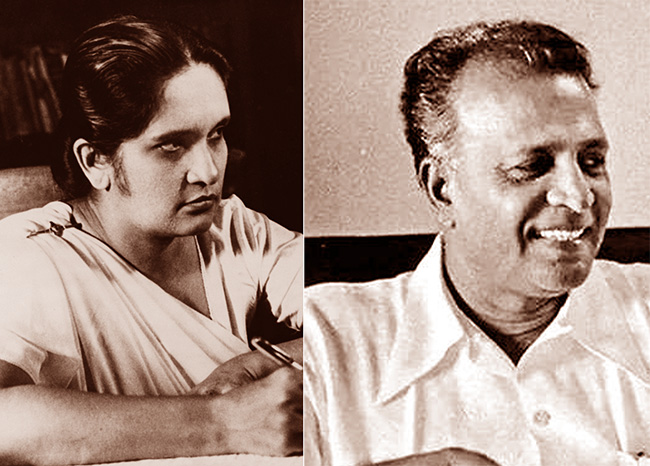
By Uditha Devapriya
On June 7, 1964, the Central Committee of the Lanka Sama Samaja Party convened a special conference at which three resolutions were presented. The first, moved by N. M. Perera, called for a coalition with the SLFP, inclusive of any ministerial portfolios. The second, led by the likes of Colvin R. de Silva, Leslie Goonewardena, and Bernard Soysa, advocated a line of critical support for the SLFP, but without entering into a coalition. The third, supported by the likes of Edmund Samarakkody and Bala Tampoe, rejected any form of compromise with the SLFP and argued that the LSSP should remain an independent party.
The conference was held a year after three parties – the LSSP, the Communist Party, and Philip Gunawardena’s Mahajana Eksath Peramuna – had founded a United Left Front. The ULF’s formation came in the wake of a spate of strikes against the Sirimavo Bandaranaike government. The previous year, the Ceylon Transport Board had waged a 17-day strike, and the harbour unions a 60-day strike. In 1963 a group of working-class organisations, calling itself the Joint Committee of Trade Unions, began mobilising itself. It soon came up with a common programme, and presented a list of 21 radical demands.
In response to these demands, Bandaranaike eventually supported a coalition arrangement with the left. In this she was opposed, not merely by the right-wing of her party, led by C. P. de Silva, but also those in left parties opposed to such an agreement, including Bala Tampoe and Edmund Samarakkody. Until then these parties had never seen the SLFP as a force to reckon with: Leslie Goonewardena, for instance, had characterised it as “a Centre Party with a programme of moderate reforms”, while Colvin R. de Silva had described it as “capitalist”, no different to the UNP and by default as bourgeois as the latter.
The LSSP’s decision to partner with the government had a great deal to do with its changing opinions about the SLFP. This, in turn, was influenced by developments abroad. In 1944, the Fourth International, which the LSSP had affiliated itself with in 1940 following its split with the Stalinist faction, appointed Michel Pablo as its International Secretary. After the end of the war, Pablo oversaw a shift in the Fourth International’s attitude to the Soviet states in Eastern Europe. More controversially, he began advocating a strategy of cooperation with mass organisations, regardless of their working-class or radical credentials.
Pablo argued that from an objective perspective, tensions between the US and the Soviet Union would lead to a “global civil war”, in which the Soviet Union would serve as a midwife for world socialist revolution. In such a situation the Fourth International would have to take sides. Here he advocated a strategy of entryism vis-à-vis Stalinist parties: since the conflict was between Stalinist and capitalist regimes, he reasoned, it made sense to see the former as allies. Such a strategy would, in his opinion, lead to “integration” into a mass movement, enabling the latter to rise to the level of a revolutionary movement.

Though controversial, Pablo’s line is best seen in the context of his times. The resurgence of capitalism after the war, and the boom in commodity prices, had a profound impact on the course of socialist politics in the Third World. The stunted nature of the bourgeoisie in these societies had forced left parties to look for alternatives. For a while, Trotsky had been their guide: in colonial and semi-colonial societies, he had noted, only the working class could be expected to see through a revolution. This entailed the establishment of workers’ states, but only those arising from a proletarian revolution: a proposition which, logically, excluded any compromise with non-radical “alternatives” to the bourgeoisie.
To be sure, the Pabloites did not waver in their support for workers’ states. However, they questioned whether such states could arise only from a proletarian revolution. For obvious reasons, their reasoning had great relevance for Trotskyite parties in the Third World. The LSSP’s response to them showed this well: while rejecting any alliance with Stalinist parties, the LSSP sympathised with the Pabloites’ advocacy of entryism, which involved a strategic orientation towards “reformist politics.” For the world’s oldest Trotskyite party, then going through a series of convulsions, ruptures, and splits, the prospect of entering the reformist path without abandoning its radical roots proved to be welcoming.
Writing in the left-wing journal Community in 1962, Hector Abhayavardhana noted some of the key concerns that the party had tried to resolve upon its formation. Abhayavardhana traced the LSSP’s origins to three developments: international communism, the freedom struggle in India, and local imperatives. The latter had dictated the LSSP’s manifesto in 1936, which included such demands as free school books and the use of Sinhala and Tamil in the law courts. Abhayavardhana suggested, correctly, that once these imperatives changed, so would the party’s focus, though within a revolutionary framework. These changes would be contingent on two important factors: the establishment of universal franchise in 1931, and the transfer of power to the local bourgeoisie in 1948.
Paradoxical as it may seem, the LSSP had entered the arena of radical politics through the ballot box. While leading the struggle outside parliament, it waged a struggle inside it also. This dual strategy collapsed when the colonial government proscribed the party and the D. S. Senanayake government disenfranchised plantation Tamils. Suffering two defeats in a row, the LSSP was forced to think of alternatives. That meant rethinking categories such as class, and grounding them in the concrete realities of the country.
This was more or less informed by the irrelevance of classical and orthodox Marxian analysis to the situation in Sri Lanka, specifically to its rural society: with a “vast amorphous mass of village inhabitants”, Abhayavardhana observed, there was no real basis in the country for a struggle “between rich owners and the rural poor.” To complicate matters further, reforms like the franchise and free education, which had aimed at the emancipation of the poor, had in fact driven them away from “revolutionary inclinations.” The result was the flowering of a powerful rural middle-class, which the LSSP, to its discomfort, found it could not mobilise as much as it had the urban workers and plantation Tamils.
Where else could the left turn to? The obvious answer was the rural peasantry. But the rural peasantry was in itself incapable of revolution, as Hector Abhayavardhana has noted only too clearly. While opposing the UNP’s Westernised veneer, it did not necessarily oppose the UNP’s overtures to Sinhalese nationalism. As historians like K. M. de Silva have observed, the leaders of the UNP did not see their Westernised ethos as an impediment to obtaining support from the rural masses. That, in part at least, was what motivated the Senanayake government to deprive Indian estate workers of their most fundamental rights, despite the existence of pro-minority legal safeguards in the Soulbury Constitution.
To say this is not to overlook the unique character of the Sri Lankan rural peasantry and petty bourgeoisie. Orthodox Marxists, not unjustifiably, characterise the latter as socially and politically conservative, tilting more often than not to the right. In Sri Lanka, this has frequently been the case: they voted for the UNP in 1948 and 1952, and voted en masse against the SLFP in 1977. Yet during these years they also tilted to the left, if not the centre-left: it was the petty bourgeoisie, after all, which rallied around the SLFP, and supported its more important reforms, such as the nationalisation of transport services.
One must, of course, be wary of pasting the radical tag on these measures and the classes that ostensibly stood for them. But if the Trotskyite critique of the bourgeoisie – that they were incapable of reform, even less revolution – holds valid, which it does, then the left in the former colonies of the Third World had no alternative but to look elsewhere and to be, as Abhayavardhana noted, “practical men” with regard to electoral politics. The limits within which they had to work in Sri Lanka meant that, in the face of changing dynamics, especially among the country’s middle-classes, they had to change their tactics too.
Meanwhile, in 1953, the Trotskyite critique of Pabloism culminated with the publication of an Open Letter by James Cannon, of the US Socialist Workers’ Party. Cannon criticised the Pabloite line, arguing that it advocated a policy of “complete submission.” The publication of the letter led to the withdrawal of the International Committee of the Fourth International from the International Secretariat. The latter, led by Pablo, continued to influence socialist parties in the Third World, advocating temporary alliances with petty bourgeois and centrist formations in the guise of opposing capitalist governments.
For the LSSP, this was a much-needed opening. Even as late as 1954, three years after S. W. R. D. Bandaranaike formed the SLFP, the LSSP continued to characterise the latter as the alternative bourgeois party in Ceylon. Yet this did not deter it from striking up no contest pacts with Bandaranaike at the 1956 election, a strategy that went back to November 1951, when the party requested the SLFP to hold a discussion about the possibility of eliminating contests in the following year’s elections. Though it extended critical support to the MEP government in 1956, the LSSP opposed the latter once it enacted emergency measures in 1957, mobilising trade union action for a period of three years.
At the 1960 election the LSSP contested separately, with the slogan “N. M. for P.M.” Though Sinhala nationalism no longer held sway as it had in 1956, the LSSP found itself reduced to a paltry 10 seats. It was against this backdrop that it began rethinking its strategy vis-à-vis the ruling party. At the throne speech in April 1960, Perera openly declared that his party would not stabilise the SLFP. But a month later, in May, he called a special conference, where he moved a resolution for a coalition with the party. As T. Perera has noted in his biography of Edmund Samarakkody, the response to the resolution unearthed two tendencies within the oppositionist camp: the “hardliners” who opposed any compromise with the SLFP, including Samarakkody, and the “waverers”, including Leslie Goonewardena.
These tendencies expressed themselves more clearly at the 1964 conference. While the first resolution by Perera called for a complete coalition, inclusive of Ministries, and the second rejected a coalition while extending critical support, the third rejected both tactics. The outcome of the conference showed which way these tendencies had blown since they first manifested four years earlier: Perera’s resolution obtained more than 500 votes, the second 75 votes, the third 25. What the anti-coalitionists saw as the “Great Betrayal” of the LSSP began here: in a volte-face from its earlier position, the LSSP now held the SLFP as a party of a radical petty bourgeoisie, capable of reform.
History has not been kind to the LSSP’s decision. From 1970 to 1977, a period of less than a decade, these strategies enabled it, as well as the Communist Party, to obtain a number of Ministries, as partners of a petty bourgeois establishment. This arrangement collapsed the moment the SLFP turned to the right and expelled the left from its ranks in 1975, in a move which culminated with the SLFP’s own dissolution two years later.
As the likes of Samarakkody and Meryl Fernando have noted, the SLFP needed the LSSP and Communist Party, rather than the other way around. In the face of mass protests and strikes in 1962, the SLFP had been on the verge of complete collapse. The anti-coalitionists in the LSSP, having established themselves as the LSSP-R, contended later on that the LSSP could have made use of this opportunity to topple the government.
Whether or not the LSSP could have done this, one can’t really tell. However, regardless of what the LSSP chose to do, it must be pointed out that these decades saw the formation of several regimes in the Third World which posed as alternatives to Stalinism and capitalism. Moreover, the LSSP’s decision enabled it to see through certain important reforms. These included Workers’ Councils. Critics of these measures can point out, as they have, that they could have been implemented by any other regime. But they weren’t. And therein lies the rub: for all its failings, and for a brief period at least, the LSSP-CP-SLFP coalition which won elections in 1970 saw through something of a revolution in the country.
The writer is an international relations analyst, researcher, and columnist based in Sri Lanka who can be reached at udakdev1@gmail.com
-
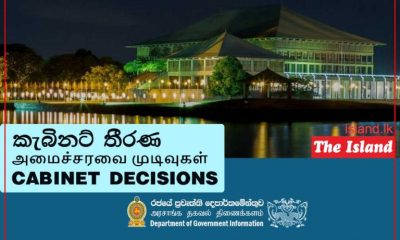
 Business6 days ago
Business6 days agoCabinet approves establishment of two 50 MW wind power stations in Mullikulum, Mannar region
-

 News7 days ago
News7 days agoGota ordered to give court evidence of life threats
-

 Features7 days ago
Features7 days agoCliff and Hank recreate golden era of ‘The Young Ones’
-

 Features7 days ago
Features7 days agoSri Lanka and Global Climate Emergency: Lessons of Cyclone Ditwah
-

 Editorial7 days ago
Editorial7 days agoExperience vs. Inexperience
-

 Features4 days ago
Features4 days agoWhy Sri Lanka Still Has No Doppler Radar – and Who Should Be Held Accountable
-

 News7 days ago
News7 days agoWFP scales up its emergency response in Sri Lanka
-

 Features6 days ago
Features6 days agoDitwah: A Country Tested, A People United













